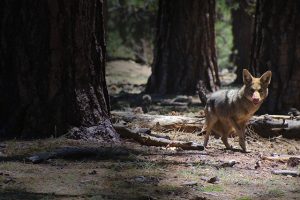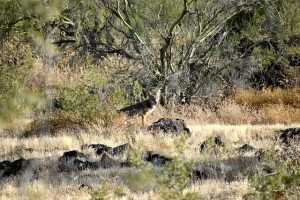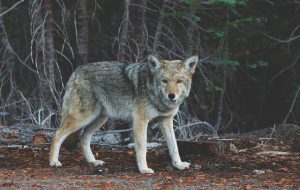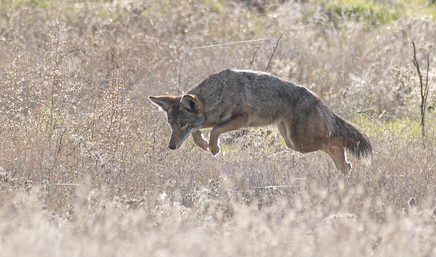Bait is just one of many ways to hunt coyotes, but it is probably the best way to train your local coyotes to where you want to hunt them and when. Additionally, baiting for coyotes versus other methods such as tracking allows you to control the environment and keep a safe distance while also giving you the most options regarding which coyotes you want to harvest and when.
Types of Bait for Hunting Coyotes

Alright, so before you go to Wal-Mart and get the biggest, cheapest sack of ground chuck you can find and throw it on the ground with your rifle in hand, you probably need to think about what coyotes eat. Coyotes will eat just about any animal they can sink their teeth into, and their diet will also consist of whatever dead animals they happen to stumble across. However, that does not mean they do not prefer one kind of bait over another.
In fact, the best kind of bait to use is a deer carcass. Deer works great for coyotes since they are a primary food source for them, and it makes them comfortable. Many people even report that when you use deer carcasses, coyotes are actually more likely than not to skip their usual downwind approach but more on that later. However, if you do not have a freshly harvested deer you can put out, do not worry since more likely than not, your local processor will have plenty of deer carcasses to give you that otherwise would have gone in the trash.
If you cannot find a deer carcass, you can use other kinds of bait. Any freshly killed, meaty animal will work well, but the best treat for coyotes that you might have good luck using are cattle carcasses. Since you probably do not have cattle at home, checking with your local farmers, slaughterhouse, or butcher shops might put you in the right direction. These also make tempting targets for coyotes and repurpose animal product that would have not been used regardless.
Choose the Bait Site for Hunting Coyotes

Deciding where you will do your bait hunting is the next most important decision you will have to make. You do not want to pick a site that does not offer a good vantage point of the bait, nor do you want one with lots of areas to enter from. The ideal location would have your bait sitting in an open area while you can be in a tree stand or elevated position close to the ground. The coyotes would have only a handful of ways to enter the area, and this is important to know because that way you will be better able to tell where your scent will carry.
By having only a select few locations where coyotes can come from, you can better prepare for the time and day you want to do your hunt so that you can time it where your scent will not be blown downwind into the coyotes’ path. As mentioned earlier, sometimes coyotes will forgo this natural inclination when they smell deer or if they are especially hungry. However, you cannot count on that.
Another factor to consider is just like coyotes, we, too, can be creatures of opportunity as humans. If you cannot find a good site or maybe just want to try something different, if you see a large, dead animal in the area, such as a deer, cow, or the like, you can sit on that carcass and hunt it. While you will not be able to control all the factors like you would with setting up your own location, you will more than likely bag you a coyote or two. While certainly not the norm, this is a good way to change things up or to not pass up on a good opportunity.
Prepare the Coyote Bait Site

Coyotes can be found out and about at all times of the time depending on the season and location, but as a general rule, are most active at night, especially during the wintertime, you can expect to see a flurry of coyote activity when it is the coldest so that they can search for food. If you really want to get a handle on when your local coyotes are active, set up a trail camera near the site and let it take pictures of when coyotes visit the bait.
In order to best train the coyotes to your bait, you can go out just during the day and refill the bait. Just make sure you come back at regular intervals to keep the bait stocked. By making sure that there is always fresh bait, you will train the coyotes to know that your smell is associated with mealtime and will have them keep coming back for more. You can also do what is called pressure baiting.
Pressure baiting is a bit different than regular baiting. With regular baiting, you replace the same amount of food each time. With pressure baiting, over time, you decrease the amount of bait that you leave out. What this does are two things. The first thing that it does is that it trains coyotes to continually check out the bait site for food more often, so you may still catch them if you are running low on bait. Less bait also means less time to eat, so you can actually train the local coyotes to come at times that might not otherwise want to do so. You could do this for a number of reasons, such as the moonlight, wind direction, or even if you just do not want to be out there too late!
Conclusion
Hunting coyotes over bait is not overly difficult, but it does take a lot of patience and analyzing how your local coyotes react to certain kinds of bait and climate conditions. By monitoring your bait site’s progress via camera, you can best tell what kinds of bait work for you, what times, and how many coyotes you can bring in with the amounts you put out.
However, one last word of caution is that baiting may not be legal in your area. Before doing so, check out the state, county, and city ordinances, and if you are still confused, reach out to your local game warden. Once you know you are in the clear, go get that deer carcass and start hunting! Good luck!


